As video production continues to boom, the demand for efficient transcription techniques is at an all-time high. Transcription not only saves time and effort but also ensures accurate and professional-looking content. In this blog post, we will provide a comprehensive step-by-step guide on how to streamline your video production process through efficient transcription.
Table of Contents
Efficient Transcription step-by-step
Let’s explore step-by-step strategies to seamlessly integrate transcription into your video production process. From preparation and tool selection to integration into video editing and workflow streamlining, each step is designed to empower you with the tools and knowledge needed to elevate your video production endeavors. Let’s dive in and unlock the transformative potential of efficient transcription in revolutionizing your video workflow.

Step 1: Preparation
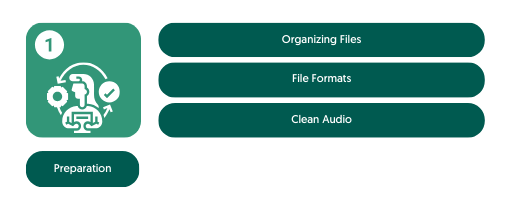
Organizing Files
The initial step towards effective transcription involves meticulous organization of audio and video assets. Create a centralized repository where all files are stored for easy access and management. Consider categorizing files based on projects, dates, or specific content types to streamline retrieval and enhance workflow efficiency. Additionally, labeling files with descriptive names can further facilitate identification and organization, reducing the likelihood of confusion or misplaced assets during the transcription process.
File Formats
Selecting the appropriate file formats is paramount to ensure compatibility with transcription tools and optimize transcription accuracy. Different transcription software may have specific requirements or preferences regarding supported file formats. Therefore, it’s essential to research and identify the compatible formats for your chosen transcription tool. Commonly accepted formats include MP3, WAV, MP4, and AVI. By adhering to compatible formats, you mitigate the risk of encountering technical obstacles or errors during the transcription process, thereby expediting overall productivity.
Clean Audio
The quality of audio recordings significantly influences the accuracy and reliability of transcriptions. To attain clear and intelligible audio, consider employing best practices such as using high-quality microphones, positioning them close to the sound source, and minimizing background noise. Additionally, conducting audio checks before recording sessions can help identify and rectify potential issues, ensuring optimal recording conditions. Furthermore, utilizing dedicated recording environments or noise-canceling technologies can further enhance audio clarity, resulting in more precise transcriptions. By prioritizing clean audio acquisition, you lay the groundwork for achieving accurate and high-quality transcriptions, ultimately enhancing the overall effectiveness of the transcription process.
Step 2: Choosing Transcription Tools
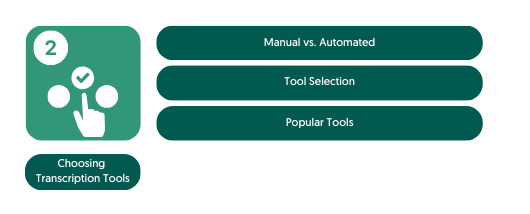
Manual vs. Automated
When deciding between manual and automated transcription methods, it’s essential to consider the unique advantages and drawbacks of each approach. Manual transcription offers unparalleled precision and control over the transcription process, making it ideal for projects requiring utmost accuracy or nuanced language nuances. However, manual transcription can be time-consuming and labor-intensive, particularly for lengthy or complex content. On the other hand, automated transcription tools leverage advanced algorithms and artificial intelligence to transcribe audio and video content swiftly and efficiently. While automated transcription offers rapid turnaround times and cost-effectiveness, it may occasionally sacrifice accuracy, especially with challenging accents or background noise. Readers should assess their project requirements, budget constraints, and desired level of accuracy when deliberating between manual and automated transcription methods.
Tool Selection
The selection of the right transcription tool is a critical determinant of transcription accuracy, efficiency, and overall project success. Factors to consider when choosing a transcription tool include transcription accuracy, turnaround time, pricing structure, user-friendliness, and additional features such as speaker identification and timecoding capabilities. It’s advisable to explore and compare multiple transcription tools, seeking user reviews, testimonials, and trial periods where available. Additionally, consider the scalability and compatibility of the chosen tool with your existing workflow and software ecosystem. By selecting a transcription tool that aligns with your project requirements and preferences, you can optimize transcription outcomes and streamline the overall production process effectively.
Popular Tools
In addition to Rev, Otter.ai, and Sonix, another notable transcription tool worth considering is Amberscript. Amberscript is known for its user-friendly interface and advanced speech recognition technology, which delivers accurate transcriptions with high levels of reliability. The platform offers a range of features, including customizable transcription options, speaker identification, and the ability to transcribe multiple languages. Amberscript also provides options for real-time transcription and integration with popular video editing software, making it a versatile solution for various transcription needs. With its intuitive interface and robust functionality, Amberscript empowers users to streamline the transcription process and enhance overall workflow efficiency.
Why you should use Amberscript
Amberscript’s services are:
Edit your text in minutes or leave the work to our experienced transcribers.
Our experienced transcribers and thorough quality controls ensure 100% accuracy of your transcripts.
Through a series of integrations and API interfaces, you can fully automate your workflows.
Your data is in safe hands. We are GDPR compliant + ISO27001 and ISO9001 certified.
Step 3: Efficient Transcription Techniques
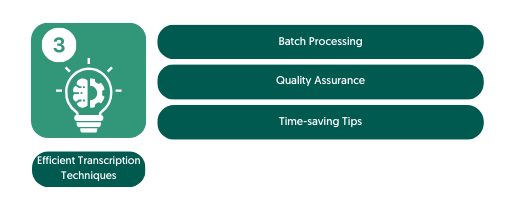
Batch Processing
Maximizing productivity in transcription begins with implementing batch processing techniques. By transcribing multiple files simultaneously, users can capitalize on economies of scale and streamline their workflow. Batch processing minimizes downtime between tasks, reduces the need for manual intervention, and enhances overall efficiency. Additionally, transcription platforms that support batch processing often feature automated file management and queue prioritization functionalities, further optimizing transcription throughput and turnaround times.
Quality Assurance
Upholding transcription accuracy and quality is paramount to ensure the integrity of the final output. Implementing robust quality assurance protocols, such as thorough proofreading and editing, is essential in this regard. After transcribing content, dedicate time to meticulously review and refine the transcript for errors, inaccuracies, or inconsistencies. This includes verifying proper punctuation, capitalization, and speaker identification, as well as addressing any contextual ambiguities. Collaborative proofreading workflows involving multiple reviewers can enhance accuracy and provide valuable perspectives, ensuring that the final transcript meets stringent quality standards.
Time-saving Tips
Enhancing transcription efficiency involves adopting time-saving strategies and leveraging available tools and functionalities. Simple techniques such as adjusting playback speed can expedite the transcription process without sacrificing accuracy. By playing audio or video recordings at a slightly slower speed, transcriptionists can better discern and accurately transcribe speech, reducing the likelihood of errors and minimizing the need for rewinding or repeated playback. Additionally, mastering keyboard shortcuts and utilizing transcription platform features can further accelerate transcription tasks. Shortcuts for pausing, rewinding, and inserting timestamps can streamline workflow navigation and editing, enabling transcriptionists to work more swiftly and proficiently. By incorporating these time-saving tips into their transcription workflow, users can optimize efficiency and maximize productivity without compromising transcription quality.
Step 4: Integration into Video Editing
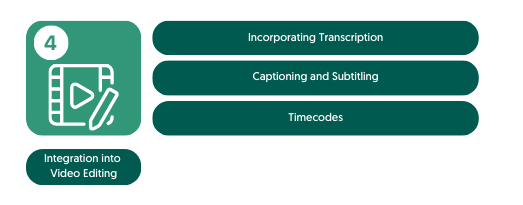
Incorporating Transcription
Seamlessly integrating transcriptions into video editing software is a pivotal step in streamlining the post-production process. Readers will discover practical techniques for importing transcribed text directly into popular video editing platforms such as Adobe Premiere Pro, Final Cut Pro, and DaVinci Resolve. This integration enables editors to access transcribed text alongside video footage, facilitating efficient editing, and enhancing workflow cohesion. Additionally, readers will learn how to customize text formatting, synchronize transcriptions with visual content, and leverage transcription metadata to streamline editing tasks and enhance overall project organization.
Captioning and Subtitling
Leveraging transcriptions for captioning and subtitling purposes offers myriad benefits, including time savings, enhanced accessibility, and improved viewer engagement. This section will delve into the process of utilizing transcribed text to generate accurate and visually appealing captions and subtitles within video editing software. Readers will gain insights into techniques for aligning text with video frames, adjusting text size and style, and ensuring proper timing and placement of captions/subtitles. By harnessing transcriptions for captioning and subtitling, editors can expedite the post-production process, comply with accessibility standards, and deliver content that resonates with diverse audiences.
Timecodes
The precise synchronization of transcribed text with video content is essential for ensuring seamless integration and enhancing viewer comprehension. This segment will explore the role of timecodes in facilitating accurate synchronization between transcriptions and video footage. Readers will learn how to insert and utilize timecodes within transcription files to denote specific timestamps corresponding to key moments in the video. Additionally, techniques for embedding timecode data directly into video editing software will be discussed, enabling editors to efficiently navigate and synchronize transcribed text with visual cues. By mastering timecoding techniques, editors can achieve optimal synchronization, streamline the editing process, and deliver polished video content that captivates and informs audiences.
Step 5: Streamlining your Workflow
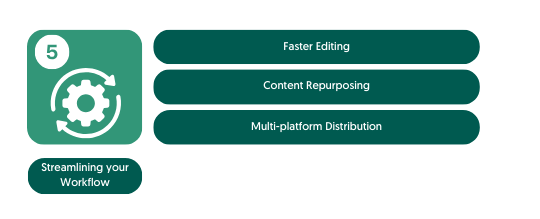
Faster Editing
Harnessing the power of transcriptions can revolutionize the video editing process by providing editors with searchable text that expedites navigation and content retrieval. This section will delve into how transcriptions serve as a valuable reference tool, allowing editors to quickly locate specific moments within footage, dialogue exchanges, or key soundbites. By leveraging transcriptions to streamline the editing workflow, editors can minimize time spent on tedious manual searching and focus on crafting compelling narratives and visual sequences that resonate with audiences.
Content Repurposing
Transcriptions serve as a versatile asset that transcends their initial purpose in video production. In this segment, readers will discover innovative ways to repurpose transcribed content for a variety of mediums, including blog posts, social media snippets, and marketing materials. By repurposing transcriptions into written articles, blog posts, or social media captions, content creators can maximize the value of their video content, extend its reach across different platforms, and engage audiences through diverse communication channels. This approach not only saves time and effort in creating additional material but also fosters consistency and coherence in content messaging and branding efforts.
Multi-platform Distribution
The strategic utilization of transcriptions for SEO optimization can significantly enhance the discoverability and visibility of video content across multiple online platforms. This section will explore how transcribed text can be leveraged to optimize video metadata, captions, and descriptions with relevant keywords, tags, and phrases. By incorporating SEO best practices into transcription processes, content creators can improve their video content’s search engine rankings, attract organic traffic, and expand their audience reach across diverse platforms such as YouTube, social media networks, and websites. By maximizing the reach and impact of video content through multi-platform distribution, content creators can amplify their brand presence, foster audience engagement, and achieve greater content monetization opportunities.
Enhancing Video Workflow: The Power of Efficient Transcription
Throughout this guide, we’ve underscored the pivotal role of efficient transcription in optimizing video production workflows. From organizing files to integrating transcriptions into video editing, each step serves as a crucial building block towards achieving greater efficiency and productivity in content creation.
As you embark on your video production journey, we urge you to put into practice the actionable strategies and techniques outlined in this blog post. By incorporating efficient transcription methods into your workflow, you’ll not only streamline your processes but also elevate the quality and impact of your video content.
Looking ahead, the future of transcription holds exciting possibilities, with emerging trends and technologies poised to further revolutionize workflow optimization. From AI-driven tools to automatic timecode insertion, the landscape of transcription continues to evolve, promising even more streamlined workflows and enhanced productivity for content creators. Embrace these advancements and stay attuned to the latest developments in transcription technology to remain at the forefront of innovation in video production.




